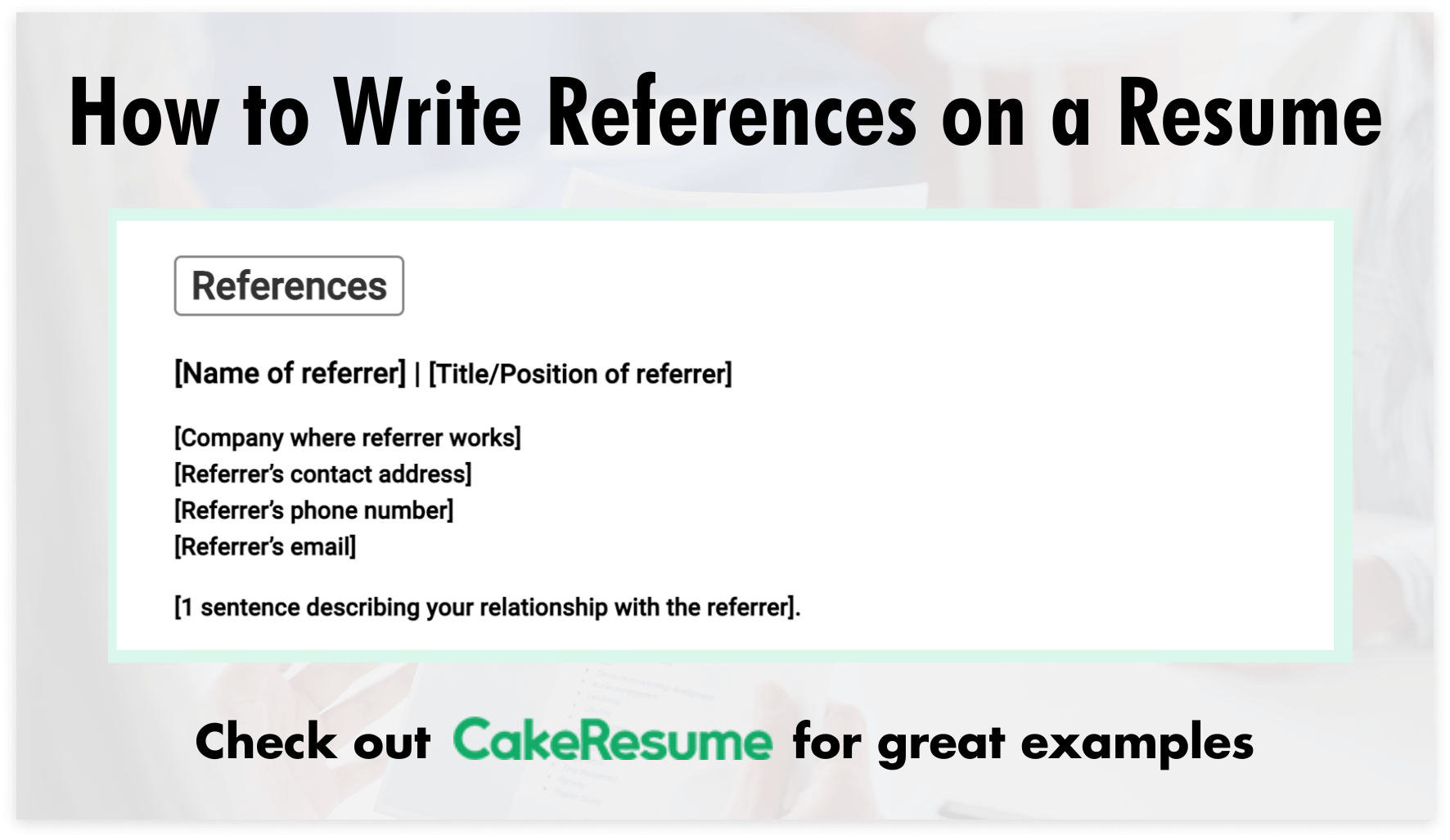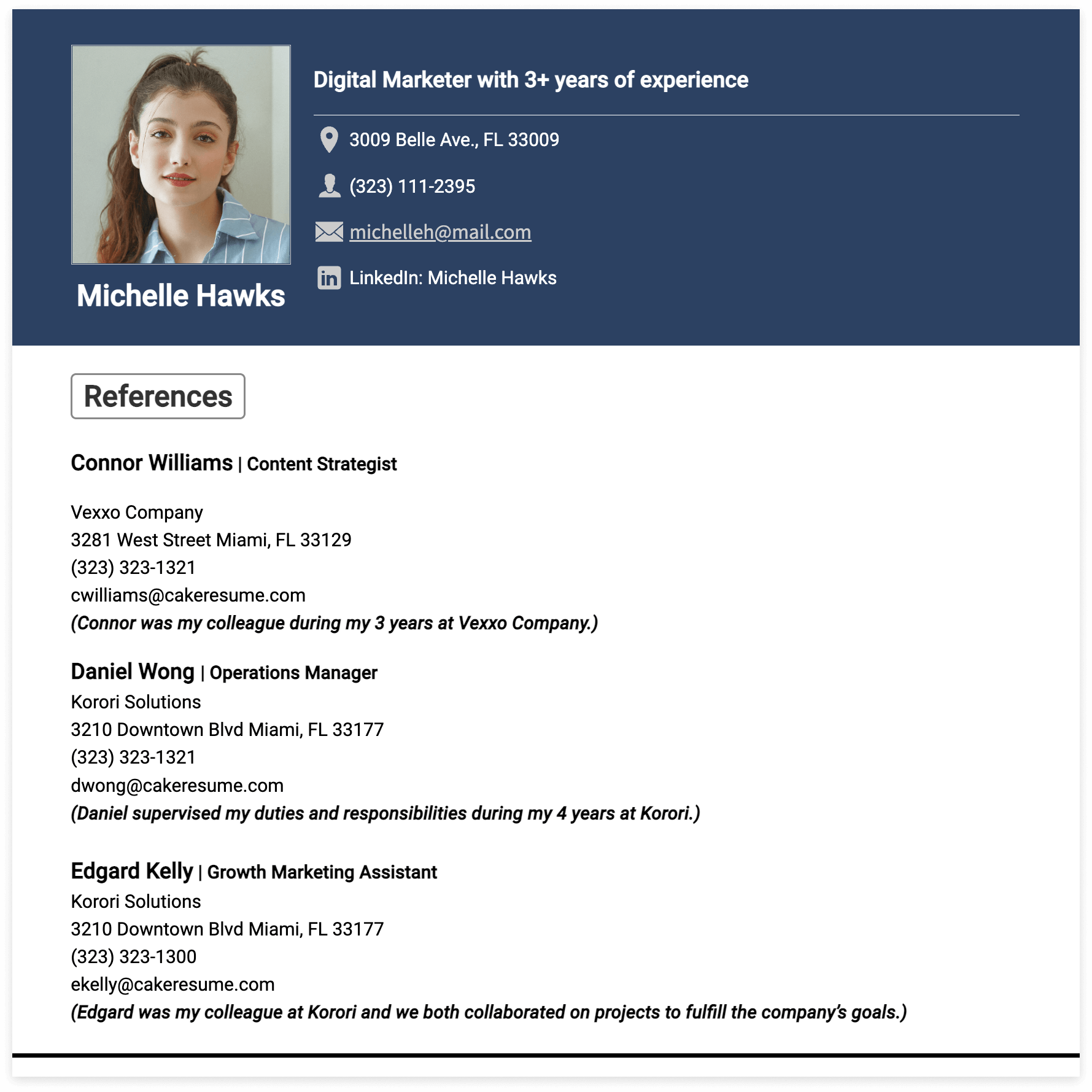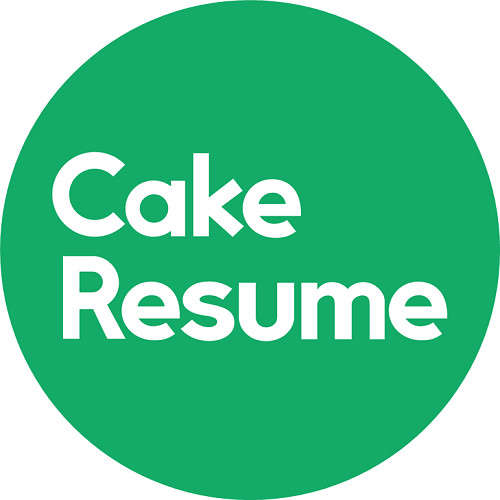Writing References on a Resume: A Guide With Examples

In this article, you’ll learn:
Professional references on a resume are a list of people who will provide information about you and your work to potential employers. Employers prefer a list of professional references because they can receive a second view of the value you'll bring to their team from a 3rd party.
Each professional reference can affirm recruiters when it comes to your character, abilities, and work performance. Recruiters want to utilize your references to double-check what you've put on your resume. References on your resume are utilized to verify facts of your job experience and to confirm many of the excellent traits they noticed throughout the interview.
Professional references vs. Character references
First and foremost, it is important to distinguish these two types of references on a resume.
A professional reference can come from people you have worked with. When putting professional references on your resume, make sure those people or contacts can provide a positive outlook on your work performance. A potential employer can contact them to ask about your performance, your tasks within a company, or your qualities in previous jobs. A list of professional references can be from former employers, colleagues, or advisors.
A character reference in a resume includes people who are familiar with the candidate's character and abilities. A character reference in a resume tends to not come from the employer. These references on a resume can be from friends, business acquaintances, or professors.
Should You Put References on a Resume?
According to resume experts, references on a resume shouldn't be included unless the recruiter specifically asks for one. HR departments are ladened with a lot more important tasks than going through each candidate's list of resume references. That's why most times, professional references aren't requested until there's a possibility of you getting hired. This, however, is not a resolute "no."
Certain job descriptions require their candidates to provide references or testimonials. Notable among them are consulting firms that require candidates to provide testimonials of their performance from their previous firm(s). So, job seekers are allowed to include their references in their resumes in cases like this. References on a resume should only be included when requested. Otherwise, you should consider them to be excluded or kept in a separate document.
Adding references to a resume is accepted in the following situations:
✅ The recruiter specifically asks for a reference list.
If the recruiter demands a reference list or page for a resume, make sure you include it in your application.
✅ You are applying for jobs in the legal field.
If you're applying for a job in the legal field, you can include your reference list in your resume. This is so the recruiter might have an idea of the cases you've worked on and the skills you have developed.
Law firms are usually very competitive, so having a list of professional references that shows a high profile of contacts, firms, and skills you've acquired would be sure to land you the job faster.
✅ You are still a student.
You can include references on your resume from people such as professors or advisors. It is advisable nowadays that students seek internship opportunities while in school to further boost their employment chances. You can also add the networks you made during this time into the reference list on your resume. This will be great as you won’t only count on your university or college.
✅ You just graduated.
Just like students, fresh graduates can also include their references on a resume.
The majority of students and fresh graduates still lack work experience and might not have contacts that could recommend them. Due to this, most recruiters allow this group to have a mix of contacts in their reference list. They could be their favorite professor, a past leader they'd worked under in school or a member of a group they headed.
✅ You still have plenty of space left in your resume.
Do take note that every word in your resume should be of value and quality. Every amount of free space counts, so you may write a professional reference section or add a list if it’s necessary.
Where Do You Put References on a Resume?
There are some common ways of listing references on your resume. Here are some things to take in mind when writing references for a resume:
✒️ Writing “References available upon request”
This common way of mentioning references on your resume is something you should avoid. Employers already know this and besides, this takes up space in your resume. Don't waste a resume line by saying something that's obvious.
✒️ A separate references section at the end of the resume
You can list your references under a separate section on your resume, just like other resume parts (e.g. work experience, skills). When listing references on a resume, make sure to place this section at the end, since other sections are more important. Remember that the references on your resume may only be considered if employers want to inquire more about you, assuming you get the job interview.
Here is an example of a resume references section:
PROFESSIONAL REFERENCES
- Steve Halloway - Business Consultant at SX Solutions
8912 East Lane Miami, FL, 33177
[email protected]
305-300-7891 - Carl Johnson - Senior Strategist at VX Technologies
2812 Bellman Avenue Miami, FL, 33129
[email protected]
305-300-7891 - Larry Stewart - Human Resources Director at GlobalVision
3820 West Road Atlanta, GA, 30305
[email protected]
404-300-8492
✒️ A separate sheet of reference list
You can dedicate a page for your professional references only if necessary.
Here is an example of a resume reference page:

How to Write References on a Resume
Here are some steps to mind when listing references on a resume:
1. Decide on the number of references to include in the resume reference list.
If you make a section for professional references, you may provide 2 or 3 references, depending on how much space you have on your resume. You can provide up to 5 references if you are using a reference sheet. Refer to each reference list example for your resume shown in this article for a better idea.
2. Think about networks who can be good references for you.
People suitable for your references on your resume are those colleagues, employers, mentors, or professors whom you had a positive relationship with. Additionally, think of contacts with whom you established a strong bond and who have praised you for your past accomplishments at work.
On the other hand, people who are not fit to be part of your references on your resume are those who you feel are not close enough. Also, people you have had conflicts with are not suitable for putting as references on your resume.
3. Reach out to the people who you want as references.
Ask your contacts if they don’t mind being listed as references on your resume. Make sure to ask for their contact details such as email, phone number, and address.
4. Determine how you want to list the reference on your resume.
Lastly, it is up to you if you want to make a section on your resume or provide a separate sheet exclusively for your professional references.
How to Format Reference on a Resume
When listing references in your resume, it is vital to have the following elements:
Name
The most basic detail that cannot be missed out on when putting references on a resume. This is how employers will know who your contacts are and thus can address them properly (if they want to contact them).
Position and company
For this element, the name of the company just suffices to save space. Any other details can be shown in the brief description part.
Address
List details such as street address and ZIP code to be clear on what branch or office you were employed in.
Phone number
It is up to you if you want to provide the office number or your contact’s cellphone. If it’s the latter, make sure your acquaintance is okay with this.
Include the work email of your professional references to maintain a professional touch.
Brief description of the referral
Give details of who the referee is and what was your relationship with them in your references on your resume.
Here is an editable resume references format you can freely use:
REFERENCES
[Name of referrer] | [Title/Position of referrer]
[Company where referrer works]
[Referrer’s contact address]
[Referrer’s phone number]
[Referrer’s email]
[1 sentence describing your relationship with the referrer].
Resume Reference Examples
In this section, here are some more examples of references on a resume. Please take a look at each sample of references on a resume to have a better understanding.
Reference in resume for freshers
Here is a resume reference list example for freshers:
REFERENCES
Sally Harrison | Professor of Organizational Management
University of Texas
110 Inner Campus Drive Austin, TX
(800) 923-7650
[email protected]
Sally was my professor in three courses and my faculty advisor for my business administration degree.
Timothy Jackson | Director of HR
Kelko Company
4234 West Street Austin, TX
(323) 323-1270
[email protected]
Timothy was my supervisor during my internship at Kelko Company as an HR assistant.
Darren Kelly | Academic Advisor
University of Texas
110 Inner Campus Drive Austin, TX
(800) 923-7650
[email protected]
Darren has been my advisor throughout my 4 years as a business student at the University of Texas.
Michael Torretto | Senior Assistant
Kelko Company
4234 West Street Austin, TX
(800) 829-3821
[email protected]
Michael was a colleague whom I worked closely with during my 6-month internship at Kelko.
Reference in resume for students
Make sure each reference in your resume contains relevant details. Here is an example for students:
REFERENCES
Richard Gawkins | Professor of Big Data Analysis
University of Florida
Gainesville, FL 32611
(600) 932-7812
[email protected]
Richard was my professor during my junior year at the University of Florida.
Fernando Argueta | Dean of Student’s Office
University of Florida
Gainesville, FL 32611
(600) 654-0861
[email protected]
Fernando has looked at my performance academically and also in extracurricular activities during my time on campus.
Nelson Anderson | Academic Advisor
University of Florida
Gainesville, FL 32611
(600) 980-3281
[email protected]
Nelson has been my academic advisor at the university from 2010 to 2014.
Reference in resume from coworkers
The last example provided displays professional references from coworkers.
REFERENCES
Yasmina Sara | Marketing Director
Cornwall Lex
3074 Despard Street Atlanta, GA
(800) 290-3820
[email protected]
Yasmina is the director I work with during my time on Cornwall Lex and is familiar with all the tasks and responsibilities I was involved in.
Terry Nimat | Director of Business and Development
Cornwall Lex
3074 Despard Street Atlanta, GA
(800) 290-3855
[email protected]
Terry is a colleague whom I communicated with while doing cross-department campaigns at Cornwall Lex.
Gunder Lambert | Social Marketing Specialist
Cornwall Lex
3074 Despard Street Atlanta, GA
(800) 290-3870
[email protected]
Gunder is a friend and former colleague who is familiar with my work experience and performance at Cornwall Lex.
Bevis Geoff | Performance Marketing Specialist
Skye Corporations
2194 Mount Olive Road Atlanta, GA
(800) 680-2810
[email protected]
Bevis is a colleague from Skye who worked with me on various marketing projects from 2011 to 2014.
Marianne Hedvig | Marketing Assistant
Skye Corporations
2194 Mount Olive Road Atlanta, GA
(800) 680-2820
[email protected]
Marianne is a colleague who I supervised and worked with at Skye during my last year working there.
🔑 Key Takeaways
Here are some important points to keep in mind when adding references to your resume:
- Employers value references on a resume, but usually, it is not mandatory to provide them when applying for jobs.
- Professional references may be needed under specific circumstances, such as applying for a job in the legal field, the recruiter asks for them, or you are still a student.
- You can decide between using a reference page for your resume or making an extra section just like the other parts of a resume (e.g. skills, work experience).
- People who are suitable for your references are those who can vouch for you and give a positive third opinion about your character and capabilities. People who are NOT suitable are those with whom you may have had conflicts or disagreements. Lastly, reach out to people you want to include in your professional references and see if they are ok with it.
- Each reference shall have the following elements: name, position, address, phone number, email, and a brief description of your reference.
With CakeResume, you can easily create a resume online, free download your resume’s PDF formats, and utilize ATS-compliant templates to create a resume. Land your dream job, create your resume online (free download) now!
--- Originally written by Jose Joaquin Rosales ---
More Career and Recruitment Resources

With the intention of helping job seekers to fully display their value, CakeResume creates an accessible free resume/CV/biodata builder, for users to build highly-customized resumes. Having a compelling resume is just like a piece of cake!






